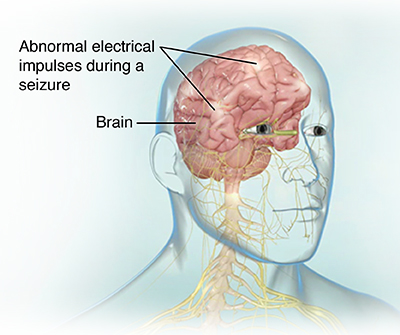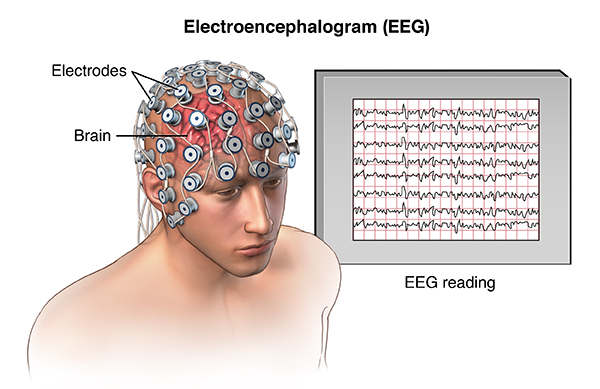What is refractory epilepsy?
People with epilepsy have seizures. During a seizure, the nerve cells in the brain don't communicate normally. The usual electrical activity in the brain becomes altered. These seizures may last a few seconds or a few minutes.
Some people with epilepsy will have or eventually develop refractory epilepsy. This means that medicines don't work well, or at all, to control the seizures.
If you have refractory epilepsy, the type of seizures you have may affect your treatment. Seizures may be:
- Generalized seizures. This means they involve a lot of your brain tissue on both sides of your brain.
- Focal (partial) seizures. This means seizure activity starts in a smaller area of your brain and may later spread out to a wider area.
Refractory epilepsy can have a big effect on your life. People with refractory epilepsy may have trouble at work or school. They may worry a lot about when their next seizure will come. They may also have injuries that result from their seizures. If your health care provider thinks you have refractory epilepsy, he or she may suggest that you visit a medical center that specializes in epilepsy.
What causes refractory epilepsy?
Some seizures have known causes, such as head injuries, infections, fevers, or brain tumors. But often the cause of seizures in epilepsy is not known. In the same way, it is not clear why some people with epilepsy are not helped by antiepilepsy medicines or why these medicines sometimes stop working.
What are the symptoms of refractory epilepsy?
The symptoms of a seizure can include:
- Convulsions, or shaking movements
- Loss of consciousness
- Confusion
- Tongue biting
- Lip smacking
- Loss of bowel or bladder control
- Uncontrolled eye movements
- Staring into space
- Falling
- Muscle rigidness, tremors, or twitching
- Odd behavior (such as screaming or yelling)
If you still have seizures while you're taking an antiepilepsy drug, you may have refractory epilepsy.
How is refractory epilepsy diagnosed?
Your healthcare provider will likely ask you many questions about your seizures. You will likely also have a test called an electroencephalogram (EEG). This involves placing electrodes on your scalp to measure your brain's activity.
Your healthcare provider may also want you to have a CT or MRI scan of your brain. If you eventually need surgery to treat the problem, your healthcare provider may do more tests like these to find out where your seizures are starting.
You will need to work closely with your healthcare provider to determine whether your epilepsy is refractory. Your provider may need to watch you closely during more seizures to try several drugs before your he or she feels your condition is refractory. Your healthcare provider may want you to check in regularly to report your symptoms as you try different medication dosages.
How is refractory epilepsy treated?
Your healthcare provider may suggest that you take other antiepilepsy medicine. You may take it alone or with others you are already taking. There are many different medicines in this class. If medicines aren't helping prevent your seizures, you may need:
- Surgery. Surgery may be especially helpful if you have refractory focal epilepsy and the area of the brain where the seizures start can be located and safely removed. Your healthcare provider may recommend surgery if you still have seizures after trying several antiepilepsy medicines. During the procedure, the healthcare provider will remove the part of your brain that's starting the seizures.
- Electrical stimulation. If you can't have or don't want brain surgery, your healthcare provider may suggest vagus nerve stimulation (VNS) with an implantable device. The device is placed under your skin at your chest area, with wires that connect to the vagus nerve in your neck. It sends a current to the nerve and may reduce your number of seizures. It may also help lessen the severity of a seizure that has already started.
- Ketogenic diet. This type of diet is very high in fat and very low in carbohydrates. Enough protein is included to help promote growth. Some patients become seizure-free when put on the diet, though researchers aren’t sure why the diet works. The diet causes the body to make ketones, which are chemicals made from the breakdown of body fat. The brain and heart work normally with ketones as an energy source. A ketogenic diet must be followed strictly, as too many carbohydrates can stop ketosis. The diet doesn’t work for everyone.
Can refractory epilepsy be prevented?
It might not be possible to prevent all of your seizures, but it is very important to use medicines exactly as your healthcare provider directs. Using your antiepilepsy drugs the right way may help them work better to control your condition.
Living with refractory epilepsy
Living with refractory epilepsy can be difficult. People with refractory epilepsy may worry a lot about when their next seizure will come. They may have trouble at work or school, and they may no longer be allowed to drive. They may also have injuries that result from their seizures. It is important to do what you can to limit your chances of injury.
When should I call my healthcare provider?
Be sure to talk with your healthcare providers about when you should call. They will likely tell you to call if:
- You continue to have seizures.
- Your seizures become worse in intensity or frequency.
- You have new symptoms during or after your seizures.
Key points about refractory epilepsy
- Refractory epilepsy occurs when your antiepilepsy medicines are no longer controlling your seizures. Usually the cause of refractory epilepsy is not known.
- Your healthcare provider will likely give you other medicines to try to get your seizures under control. If this does not work, other options may be surgery to remove the part of the brain where the seizures start, electrical stimulation of a nerve leading to the brain, or the ketogenic diet.
Next steps
Tips to help you get the most from a visit to your healthcare provider:
- Know the reason for your visit and what you want to happen.
- Before your visit, write down questions you want answered.
- Bring someone with you to help you ask questions and remember what your provider tells you.
- At the visit, write down the name of a new diagnosis, and any new medicines, treatments, or tests. Also write down any new instructions your provider gives you.
- Know why a new medicine or treatment is prescribed, and how it will help you. Also know what the side effects are.
- Ask if your condition can be treated in other ways.
- Know why a test or procedure is recommended and what the results could mean.
- Know what to expect if you do not take the medicine or have the test or procedure.
- If you have a follow-up appointment, write down the date, time, and purpose for that visit.
- Know how you can contact your provider if you have questions.











